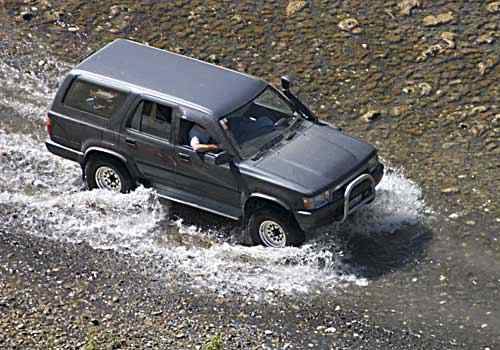A river runs through our farm: in fact it is half of our boundary line. In some places, our boundary is in the middle of the river, in others there's some Crown (government) land, and in still others it's not entirely clear who owns what. The Waipara River defines our property. We look down on it from our clifftop, swim in its deep pools, fish in the holes (brown trout up to 2.5kg - old, wily fish that challenge the fly fisherman), walk up the river bed through the gorge enjoying the geological time machine it reveals, and watch the birds that make it their home.
Unless a convoy of four wheel drive vehicles gets there first. The problem is that "our" stretch of river is a popular four wheel drive excursion, with a page to itself on the net, described in the South Island 4WD guide book as ideal for novices. On a summer weekend, convoys of cars splash up along the river, following a track so well-defined it could pass for a country road. As they criss-cross the main stream of the river they stir up clouds of mud, spoiling the swimming and fishing for hours. Any wildlife disappears. Little rainbow sheens of oil shimmer on the river surface. It might be two cars, it might be 20. But whatever, they've ruined it for the rest of the us.

Splashdown. Big fun for big boys with big cars.
I have a 4WD vehicle, an SUV with a big engine and lots of "grunt". It even goes off-road occasionally, towing trailers on farm paddocks, or up the vertiginous and rough roads to the ski-fields of the South Island. I can understand some of the attraction of using your car to take you into the great outdoors. But I don't understand why the rights of the 4WD community have to take precedence over the walkers, swimmers and fishermen who love the river and its gorge. It's a place of spectacular scenic value. But it gets used as a proving ground for 4WD drivers. They love "testing" their vehicles in the water. On the first site linked above, the author boasts about having got his car through the narrowest part of the gorge, where the mud is deep and swallows hang their mud nests under the carved limestone. My neighbours are regularly asked to get their tractor out to rescue people bogged in shingle or mud. They treat the river bed as an obstacle course, leaving tyre tracks and skidmarks everywhere. And don't get me started on the trail bikes, whose little two stroke engines make the most incredible, ear-shattering noise, ruining the peace of the entire valley. Worse, in high summer when the river banks are tinder dry, one spark or a carelessly tossed cigarette stub could start a fire and burn me out of house and home.
I have, from time to time, tried to suggest to a 4WD driver crossing a bit of the river within my boundary that they might like to turn round and go back. I have been shouted and sworn at. They insist that they have an absolute right to drive their vehicles up this "public property", just as they insist that they have a right to drive along the beaches of Pegasus Bay, ruining sand dunes and scaring beach users. Their rights are more important than our rights to enjoy peace, quiet and an unspoiled environment.
I was prompted to write this piece by an item on tonight's news. A high country farmer blocked access to a new Department of Conservation park in the Southern Alps, preventing its official opening as a protest because DOC had locked a gate in the reserve, preventing 4WD access to the best bits. DOC wanted the high valley kept pristine for fishermen, walkers and the wildlife. Apparently 4WD rights take precedence there as well.
The South Island of New Zealand is a big and beautiful place. Everyone has to accept some restrictions if it is to remain beautiful and unspoilt, and if the enjoyment of the majority is not to be ruined by the pleasures of the few. If Canterbury's 4WD enthusiasts want to test their vehicles, let them be given defined areas where they can have fun and will harm no-one. There are plenty of suitable places. But if they want to see the Waipara River and its gorge at its best, let them park their cars and walk, or ride a mountain bike or horse. I might even offer them light refreshments after encouraging them to swim in "our" swimming hole.
[June 2007: Note for visitors from Offroad Express. I see you're as happy to ignore the copyright laws (by reposting this piece without permission) as you are to rip up the riverbed.]

.jpg)


